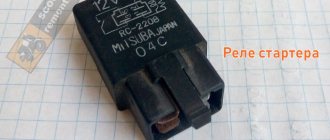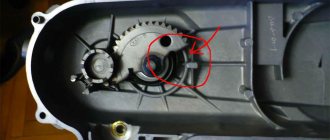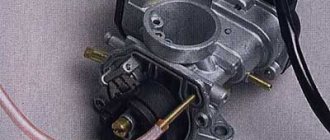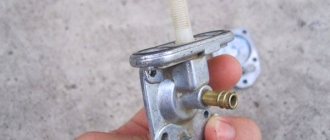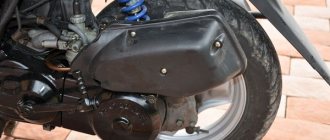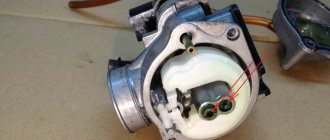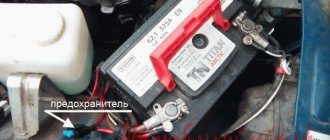Typical reasons
First of all, you need to check: the ignition and power systems. Carry out a check in those places that can cause the moped to move. The reasons why the scooter does not start, especially in cold weather, may be the following:
No spark in spark plug
The scooter does not start because there is no spark in the spark plug. In this case, you need to do the following: the spark plug is unscrewed and checked for suitability. Connects to the ignition coil using a wire. Placed on the cylinder. When the crankshaft rotates, the spark at the spark plug is checked. The scooter will not start if there is no spark at the plug, or there is a spark, but it is inconsistent.
Reasons for the lack of spark on the spark plug
Cold weather
The scooter may have difficulty starting in cold weather if there is a problem with the spark plug cap or its connector. In such a situation, the cap is unscrewed from the wire, and the wire is brought 0.3 cm closer to the metal motor element to crank the crankshaft.
A moped can carry current in cold weather. This happens due to the fact that there is contact with the exposed part of the wire and the metal element due to which the scooter starts.
Malfunctions in the power system
A moped may have difficulty starting in cold weather if there is a problem in the power system: lack of fuel or its excess. In this case, you need to check the following elements: gas tank, fuel tap, starting enrichment and fuel pump.
First of all, check the moped's fuel pump
Along with this, it is worth noting that the moped needs to be repaired, and parts should only be disassembled if there is complete confidence that they are faulty. It is best to install only new parts on the scooter, and not used ones, otherwise the engine, when started from the starter, will either work poorly or will not start at all.
Checking Basic Systems
In order to understand why the scooter does not start, the problem must be looked for sequentially:
Supply system
After checking the electrics and making sure that everything is in order, you should get to the power system: if the fuel is supplied in the wrong amount, the scooter may not start. If there is a large amount of fuel, the carburetor overflows and the spark plug becomes wet, and if there is little fuel, there is not enough of it for the piston to move. To do this, you need to adjust the jet, floats and needle, moving the limiter on it. It wouldn't hurt to check the gasoline pump either: sometimes it simply fails, so the fuel doesn't go anywhere.
Ignition system
The entire ignition system must be checked if there was a spark and then disappeared. If the spark plug and coil are normal, but there is still no spark, you will have to check more thoroughly. The coil, generator winding, and switch come under suspicion. A multimeter can check all this: for example, they test a generator like this - one probe is connected to the engine crankcase, the second to the generator sensor.
The resistance of a working sensor is 500 Ohms. If the value is higher, the winding is faulty; if it is below 200 Ohms, the problem is in the coil.
Reasons for lack of spark
Often, owners may encounter cases of starting failure in the cold season, although the moped drove well in the autumn. Initially, you need to unscrew the spark plug and carefully inspect for spark, oiliness and color.
Carbon deposits on the electrode
There may be no spark, if the electrode is covered with carbon deposits, then they are cleaned with a metal brush. If there is even the slightest doubt about the serviceability of the spark plug, you should replace it immediately, thereby making your life easier in the future.
Acidification of contacts
If the external signs of the spark plug correspond to suitability, and there is also no spark, then you need to check whether there is a discharge. It is worth noting that you need to be extremely careful, as it can give you an electric shock. If there is no spark and the external signs of the spark plug are normal, then the scooter is checked electronically for acidification of the contacts.
Insufficient fuel
If there is a spark, but the moped still has difficulty starting from the starter in cold weather, you should pay attention to the fuel tank. If it is empty, then it is filled. It is worth noting why old gasoline pours out of the carburetor float chamber. How to do it? There is a bolt at the bottom of the carburetor; it is unscrewed, and after all the fuel has flowed out, it is screwed back in. Before putting the moped in the garage in cold weather, fill the tank full of fuel.
Unscrew the bolt and pour out the old gasoline from the carburetor float chamber
If the above has been checked and done, and the scooter does not start well from the starter, then you can make the following repairs:
- The carburetor is removed and the air filter is cleaned;
- The carburetor is cleaned, the jets and channels are purged;
- Everything is coming back together.
The spark plug is faulty, the gap is incorrectly set, or the electrodes are covered with a black velvety coating
The next step is to check the spark plug. Of course, the glow number and rating of the spark plug should be as recommended by the scooter manufacturer. You should not use the first candle you find in the garage.
Now check the electrodes. They should be clean, without black velvety deposits, brick-colored.
The spark plug gap should be in the range – 0.6 – 0.8 mm.
At the slightest contamination, the spark plug must be cleaned and the gap checked again.
The presence of black carbon deposits in this case also indicates that the engine is running on a rich mixture, which means that the carburetor should be adjusted.
How to restore starting from the starter
The moped does not start well from the starter, however, doing it from the foot is simple and easy. If the engine does not start well from the starter, you must first check the fuse located in the battery compartment.
The location of the fuse on the battery is marked with an arrow.
Due to the often poor quality of the manufacture of the fuses, and, consequently, the entire starter, the wire located inside the starter glass bulb can barely touch the contact caps, which is why the fuse contact becomes unsuitable. After the low-quality fuse has been replaced, the moped can be started using the starter.
How to start a moped in cold weather
There is no snow at all on some highways in the winter, so you can drive on them without any problems. But the “iron horse” is not always ready to start easily at subzero temperatures. Now we will tell you how to properly operate a moped in winter.
The first step in winter is to refuel with fresh gasoline, and also be sure to replace mineral oil with synthetic oil. If you leave it, the mineral oil will always be thick in the engine, and this will have a detrimental effect on its performance. To start, it is better to use a kickstarter rather than an electric starter, since the battery voltage sags greatly when exposed to cold. When starting, add a little more gas than usual, so the engine will not stall. Sometimes, when the oil thickens, some smart people heat it up using a gas burner. In modern vehicles this usually does not happen if the oil is synthetic.
If you follow all starting recommendations, the moped will start at a temperature not lower than -20 degrees Celsius. When you are able to start it, we recommend letting the engine warm up for at least 5-10 minutes.
The wires may vary in color, so you perform all actions at your own peril and risk. Remember, if done incorrectly, all electronics may fail.
How to do your own engine repair
For a scooter engine to function properly, it requires the following components: spark, fuel and compression. The main slogan of a scooter mechanic is that miracles do not happen. Remember that in the process of troubleshooting and repairing a scooter, you can find out whether there is a spark and compression, or why there is no fuel flow. Therefore, if the engine does not start from the starter, then some component is missing or is in a faulty condition.
Many people are familiar with the situation when they are not only too lazy to take their scooter to a workshop, but also don’t want to pay for it all. Then you can repair everything yourself.
Other answers in this thread
#2 SergUA
- Participant
- Group: Users
- Posts: 271
- Registration: 04 April 06
Fallen36 (10/3/2007, 5:06 pm) wrote:
First of all, use the search, and when it stalls, look at the filter, carb, exhaust.
#3 Vlad
- Authority
- Group: Users
- Posts: 2,045
- Registration: 03 March 06
Fallen36 (10/3/2007, 5:06 pm) wrote:
If the battery is charged, this does not mean that it holds the starting current. Light up your car. It will start, charge the battery. No, look for oxidized terminals on the relay and starter, measure the current at the starter, maybe the brushes are finished.
And if so, it stops starting from the starter when the piston is dead. Measure the compression.
Post edited by Vlad: 03 October 2007 - 16:27
#4 Fallen36
- Participant
- Group: Users
- Posts: 238
- Registration: 23 September 07
#5 Mitenka
- Old timer
- Group: Users
- Posts: 1,097
- Registration: 30 April 06
Fallen36 (3.10.2007, 19:45) wrote:
#6 Fallen36
- Participant
- Group: Users
- Posts: 238
- Registration: 23 September 07
Post edited by Fallen36: 03 October 2007 - 19:25
#7 DjanoWaR
- Participant
- Group: Users
- Posts: 103
- Registration: 21 May 07
#8 Fallen36
- Participant
- Group: Users
- Posts: 238
- Registration: 23 September 07
#9 SergUA
- Participant
- Group: Users
- Posts: 271
- Registration: 04 April 06
Fallen36 (4.10.2007, 16:23) wrote:
I wrote to you, clean the filter and carb, check if the pipe is clogged.
Sequence of repair actions
The main rule for detecting malfunctions and repairing a scooter is to step-by-step eliminate the elements of the system when identifying the causes of a breakdown in any of them. Search and repair, especially when starting from the starter, must be done in accordance with a strict sequence, where the chain may act as the beginning, and the end, for example, if there is or is no spark. It is worth noting that you do not need to immediately run for a new switch for the scooter, first make sure that the generator is functioning perfectly, only after that test the wiring if there is no spark, etc.
Checking Basic Systems
It is important to remember that gasoline has the ability to lose its properties if it sits in cold weather and may not even ignite. Also, before making a final diagnosis and starting to repair the moped, if it does not start from the starter, you need to make sure that the spark plug can do its job and the carburetor is functioning normally.
Remember that the scooter starts from the starter when it has an integral part with proper operation of the variator, clutch, camshaft group and valve. To put it simply, if all power systems are in normal condition, then there is a problem in the transmission, thanks to the crankshaft torque, which works closely with the variator.
In the process of diagnosing and repairing a scooter, in some cases it is necessary to do a thorough check of not only individual elements, but also the entire system. For example, if there is debris in the carburetor, provided that it is intact and the air filter is saturated, the presence of dirt in the cavity of the gas tank and the fuel filter is also carefully examined.
Liquid or dirt in the air filter
Check your scooter's air filter. It must be clean and soaked in oil. Some filter boxes, when the scooter is used intensively in rainy weather, and even in deep puddles, allow water to pass through perfectly, which is why the filter element (usually foam rubber) absorbs moisture and the mixture is sharply enriched. Sometimes drops of water can get into the carburetor from here, which naturally should not be there. This point also cannot be excluded.
Sometimes a situation happens when the scooter works normally without problems, but when you need to start it in the cold, problems begin. The scooter may start poorly when cold or not at all. Therefore, today we will find the answer to the question why the scooter does not start well when cold.
Why the scooter does not start with the button - we identify the reasons
A scooter is a practical vehicle, economical and easy to drive. Modern models are reliable and easy to maintain, but various problems may arise during the operation of the scooter.
One of the most common breakdowns is the failure of the scooter to start with the button.
As a rule, at first the scooter starts from the button every other time , and then does not start at all using the electric starter. How to be in this case?
To fix a problem, you need to identify the cause of its occurrence. As practice shows, there can be many such reasons, but there are also quite common ones.
What to check if the scooter does not start with the button
It will be useful: Repairing a charger for a car battery: how to repair and troubleshoot
We will list the most common reasons and give ways to solve them:
- Fuel sensor malfunction. No matter how trivial it may sound, this happens quite often: the sensor shows that there is still gasoline left in the tank, and the owner of the scooter looks for the cause of the “breakdown” in a completely different place. Therefore, it would not be superfluous to first look into the gas tank and make sure that there is fuel in it.
- The battery is low. This often happens when equipment is idle for a long time. To solve the problem, just charge the battery.
- Old fuel. Many scooter owners face this problem after winter. There seems to be gasoline in the tank, the electric starter seems to be turning, but something is missing to start the engine itself. The cause of this problem may be old gasoline, try draining it and adding fresh fuel.
- There is no spark in the spark plug. To check this version, you need to unscrew the spark plug, apply it to an unpainted part of the engine (for example, to the cylinder), and use the kickstarter to crank the crankshaft. At the same time, you should not neglect precautions: you should not hold the candle with your bare hands. If there is no spark, the spark plug must be cleaned of moisture and carbon deposits, sanded with zero-grit sandpaper and dried. Ideally, the spark should be white.
- Poor contact at the battery terminals - over time they can become covered with oxide, which is a dielectric. To get rid of this problem, just clean the contacts with the same fine sandpaper.
- The fuel tap and/or fuel line is clogged. If gasoline does not flow into the ignition system or is supplied intermittently, the scooter will not start either from the kickstarter or from the button. To fix the problem, these elements of the fuel system need to be cleaned.
- The carburetor is clogged. Difficulty starting the engine, “floating” speed, failures in engine operation - all this indicates that the carburetor needs cleaning. To remove the carburetor, you need to unscrew the inlet pipe and the air filter pipe, disconnect the terminals of the starter enrichment, remove the gasoline supply pipe and drainage. Then you need to disconnect the throttle cable and you can remove the carburetor. Next, you should carefully disassemble the power system assembly, clean it and put it back together. After cleaning the carburetor, do not forget to adjust the floats to a horizontal position!
- No compression. Inspect the piston group. When the piston moves to top dead center, pressure should appear in the cylinder. This can be checked using a special device - a compression meter. To do this, screw the compression gauge fitting in place of the spark plug and turn the crankshaft using the kickstarter. On 2-stroke scooters the compression should be 7-8 kg/cm2, on 4-stroke scooters - 9-10.
The starting enrichment is faulty or does not work
The second reason is that the starting enricher does not work. For normal starting of the scooter engine when cold and stable operation at idle before it warms up, the carburetor must prepare a slightly enriched mixture compared to normal operation. The mixture is enriched by opening an additional fuel channel using an automatic starting enricher. In fact, the role of the starter booster is often underestimated by scooter riders and this point is overlooked. If there are no problems during a hot start, but during a cold start and stable operation after starting is difficult, the carburetor is still clean and the compression is normal - be sure to look at the starting enrichment. How to check it was described in detail in this article.
If the scooter starts with the kickstarter, but does not start with the button
If the scooter starts without problems from the “leg”, but does not want to start from the electric start button, then you should pay attention to the central fuse (it is located in the compartment with the battery). If the voltage in the scooter’s electrical network is too low due to a faulty fuse, it will no longer start using the “Start” button.
To check the serviceability of the central fuse, you should measure the voltage at the battery terminals and compare with the voltage after the fuse.
If losses are detected during measurements, the fuse should be replaced. In most cases, after replacing the faulty fuse, the scooter starts without problems.
The problem when the starter button on a scooter does not work may not only be in the fuse. It is likely that the integrity of the connecting conductors in the engine starting circuit is broken.
VIDEO INSTRUCTIONS ” alt=””> It will be difficult for a beginner to deal with such a malfunction, so for a complete diagnosis of the electrical circuit it is better to contact an auto electrician.
Wear of the CPG and engine parts
We start with a compression test. The first sign of a significant drop in compression is the lack of proper resistance when pressing the kick starter lever.
Compression is measured using a compression meter, after which, if it drops below permissible values, the engine is repaired with the obligatory replacement of damaged parts. The cylinder of a two-stroke engine, if necessary, is bored by specialists, and a repair piston with rings is purchased. We discussed compression in more detail here.
Main breakdowns and methods for solving them
On scooters, the electric starter often fails. Of course, Kickstarter can help out, but it’s not very convenient to use. The engine may not start due to a faulty battery: the contacts have come loose, the charge has run out, the device is worn out. If there is no spinning sound when the starter turns on, then the problem is in the battery. If you can’t charge it, it means it’s out of order, worn out and you’ll have to install a new one.
If pressing “Start” does not produce a click in the electric starter relay, the problem is more serious. The unit may be faulty and needs to be replaced. The problem can arise when various components wear out. Most often they need to be replaced.
You can fix some scooter problems yourself
Electric starter does not work
If the scooter does not start from the foot, then its operation is impaired. If the electrical circuit is working properly, but the relay clicks when you press “Start,” then the problem is a bad contact or a broken starter.
To evaluate its performance, you need to apply voltage to it without activating the relay. If the electric starter does not turn, then it needs to be replaced.
Starter relay failure
The relay maintains the voltage at the required level for further distribution to headlights, dashboard indicators and other elements. Its durability depends on the battery. If the voltage in the generator increases or decreases, the relay is faulty. Because of this, the starter does not start. In this case, the relay needs to be replaced.
Problems with the button
When the Start button is pressed, the starter rotates and drives the engine gears. If the scooter does not start with the electric starter button, there is a malfunction. The wiring in the engine starting system could have come loose. If the scooter starts from the foot, but not from the “Start” button, then the fuse is faulty: the voltage in the generator drops, so the button does not work.
To check the functionality of the fuse, you need to measure the voltage at the battery terminals and in the fuse. If losses are detected, a new fuse must be installed. After replacing the part, the moped will start from the “Start” button.
If the scooter breaks down, the electric starter may not work.
Broken brake contact (toad)
The brake system needs regular inspections, as driving safety depends on it. A breakdown of any other scooter system is easy to identify, since engine operation is disrupted. Brake failure can only be detected by diagnosing the vehicle. During the inspection, you need to check the integrity of all parts and the amount of brake fluid.
Replacing brake fluid is necessary every 8-11 months, depending on the intensity of use. In this case, you need to use the liquid recommended by the manufacturer. If the brake pads are worn down by 2 mm, they need to be replaced. Hoses need to be replaced if there are cracks or abrasions.
If system parts are worn out, brake contact is lost. Because of this, the engine will not start.
Contacts have come loose or oxidized
If the scooter does not start, the reason may be the contacts with the battery. It is necessary to check if they are charged. This must be done carefully to avoid electric shock. If there is no spark, you need to check the electronics. Most often the reason is oxidation of the terminals. When they become coated, the scooter does not start moving from the starter. You can clean the contacts with sandpaper or gasoline.
Contacts with the battery may be the reason if the scooter does not start
Bendix doesn't work
The starter fails due to careless handling of the bendix - the starter wire that engages with the engine flywheel and powers it. When the engine starts, a special mechanism with a relay pulls the bendix into the starter, stopping the engagement. Inexperienced drivers most often encounter Bendix breakdowns.
If in winter the engine does not start on the first try, they hold the "Start" button for a long time and spin the engine. The flywheel cannot rotate at the specified speed, causing the drive to jam. As a result, the starter overheats and the bendix fails. This may cause the starter housing to burst. Depending on the degree of damage, replacement of the bendix or the entire system is required.
It will be useful: Problems with the VAZ 2106 starter (does not turn, does not click, etc.): how to remove and repair?
The battery is dead or damaged
If the scooter refuses to move after starting the starter, you need to try starting it using the kickstarter. The battery may have run out. If you couldn't charge it, it means it's completely out of order.
Fuse blown
Due to damage to the power system, no current flows to the battery, so it does not charge. When the battery is charged, the engine stalls and does not start either with the kickstarter or the electric starter. The most common reason is that a fuse with a lower capacity than recommended by the manufacturer is installed. If the new fuse fails quickly, the electrical circuit is faulty. If a short circuit occurs, the wires need to be replaced.
Inexperienced drivers most often encounter bendix failure
Crankshaft seals are leaking
The front oil seal may leak after a mileage of more than 100 thousand km. In working condition, it fits tightly to the crankshaft. When the crankshaft beats, the inner surface of the oil seal cracks. Because of this, it cannot press tightly to the surface. Leakage can also occur due to the use of low-quality oil.
Another reason for the malfunction is related to engine failure. As pressure increases, crankcase gases create a gap in the oil seal through which oil flows out. The reason for leaking of the new oil seal may lie in the poor quality of the part itself or improper installation. If you bend the inner edge of the rubber when installing it, oil will flow out through it. In this case, the oil seal must be replaced.
If the rear oil seal leaks, oil can get onto the clutch disc and render it unusable. To replace it you will need to remove the box, clutch and flywheel.
Low compression
Compression in an engine is related to the mixing of fuel with air. The process is important for normal engine operation. A decrease in the indicator is very easy to determine: the engine does not start on the first try or does not start at all with low compression in all cylinders. Most often this occurs due to overheating or wear of the valves. Gases escape too quickly, causing compression to decrease.
The compression test takes about an hour. The indicator is measured by a compression meter. If low compression is detected, you need to check the condition of the cylinders, valves, gaskets and pistons. After replacing the damaged parts, compression will return to normal.
Low compression may be the cause
Old fuel
This problem occurs after winter. The tank is full of gasoline, but the electric starter does not start the engine. The reason is old gasoline. You need to drain it and fill the gas tank with new fuel.
No spark in spark plug
Diagnosing a breakdown is easy. You need to unscrew the spark plug, connect it to the ignition coil using a wire and place it on the cylinder. If there is no spark when the crankshaft rotates, the spark plug needs to be replaced.
Poor contact at battery terminals
Oxidation or poor terminal contact on the battery prevents the engine from starting. Diagnostics can be easily performed by visually inspecting the connection points between the terminals and the battery. If they are covered with a white coating, it means that the contact has been broken. It's easy to fix the situation. You need to remove the terminals and clean the deposits with sandpaper, then screw them onto the battery and cover the connection points with a special lubricant. If it is not there, you can use technical Vaseline.
Carburetor clogged
Difficulty starting the engine or failures in its operation occur when the carburetor becomes clogged.
When the carburetor becomes clogged, the engine becomes difficult to start or fails to operate.
To remove it, you need:
- unscrew the pipes;
- disconnect the terminals;
- remove the tube and drainage;
- remove the throttle cable;
- disassemble the carburetor assembly, clean it and put it back.
No compression
If the spark plug and battery are working fine, but the engine still won't start, then there is a compression problem. You need to check the pressure using a compression gauge. Lack of compression indicates a broken compressor ring. After replacing them, you can continue using the scooter. The procedure is quite complicated, so it is better to contact the service.
Cold weather
If the scooter stalls in the cold, it means that the spark plug cap or its connecting element is broken. It is necessary to unscrew the cap, bring the wire 3 mm to the motor element and rotate the crankshaft. In cold weather, a moped conducts current when a bare section of wire comes into contact with a metal element.
The starter does not start due to carbon deposits on the electrode
Carbon deposits on the electrode
Due to carbon deposits on the electrode, the starter does not start. The deposits must be carefully removed with a plaster zero. But it’s better to put a new candle in. It is advisable to buy a part that is recommended by the manufacturer.
Insufficient fuel
If, even though all systems are working properly, the moped does not move, it means there is not enough fuel in the tank. The indicator on the dashboard may have broken, indicating a lack of gasoline.
Ignition system
If the scooter does not start well when cold, then you need to check the spark plug. We check the electrodes; if there are defects, then the spark plug is damaged and needs to be replaced. If the spark plug is wet, then of course you need to dry it and check if there is a spark. If there is NO spark, then you need to check where and what can eat it.
Since the spark plug is normal but there is still no spark, you need to check the spark plug cap and connections to it. First, check that the cap has contact with the high-voltage wire. To do this, you need to unscrew the cap and bring it to the engine (no closer than 2 mm), or rather to its metal part. Twist the crankshaft and see if there is a charge between the cap and the part where we lifted it. If the charge starts, then the problem is in the cap. Check it for defects and moisture. If you can’t make it, then simply replace it with a new one and the problem is solved. If there is NO charge, then you need to check where the charge can go. It could be water or an exposed piece of wire touching a metal part into which a charge is transferred.
Rules for operating a moped
The service life of a moped depends on maintenance. Care comes down to following the rules recommended by the manufacturer.
The main ones include:
- Testing a new scooter. The first concerns the running-in of a new scooter. The scooter must not be overloaded for the first 1000 km. When driving for a long time, you must stop every 30 minutes to prevent the engine from overheating.
- Correct use in winter. You need to drain the fuel before storing the scooter in the garage for the winter. Remaining fuel can destroy the tank and flood the carburetor. If you plan to use the scooter in winter, you need to change the fuel, check the battery charge, oil level, condition of the filters and tire pressure (it should be about 1.5 atmospheres).
- Correct use in summer. In hot weather, it is important to prevent the scooter from overheating. When driving for a long time at 30 degrees, the cylinders will be constantly overheated. This could cause the belt to break or the engine to break down. You should also not squeeze the throttle for too long, and when stopping, immediately turn off the engine.
- Use quality fuel. Gasoline must be at least 92. On a new moped, you need to change the oil for the first time after a run of 500 km. Subsequent replacement will be required every 1000 km. The first time to change the oil in the rear gearbox is after 200 km, then every 5000 km.
- Replacing the variator belt. This part is considered a consumable item, as it wears out quickly due to the high power load. If the moped stops squeezing out high speed, then the part and its components need to be replaced.
- Carburetor maintenance. The procedure includes a visual inspection for leaks and gasoline consumption levels, checking the condition of the connecting elements and the serviceability of the unit elements.
- Filtration quality control. The filter must be replaced promptly and impregnated with a special product after installation. This is necessary for high-quality air purification. Dirty air reduces the life of the motor.
How to start a moped from a pusher
While there are two main ways to start an engine, there are many other options as well.
With a rope
The first step is to get to the generator, which is located on the back side, in any way that is harmless to the equipment. We find the impeller there - you need to wrap a rope around it 5 times clockwise, to do this you can tie a knot at the end of the rope and insert it from the very beginning between a pair of blades. And then you will need to pull it hard, you may not succeed the first time, so most likely you will have to make several attempts.
You can learn more about this method from the video:
From the pusher
People have the opinion that if a moped has a CVT, then it cannot be started in this way. In fact, this is just a myth; experts have carried out tests many times - nothing bad will happen.
For this method to work, you need to get to the clutch bell; to do this, carefully remove the protective cover of the variator. Next, we will need to lock the bell and clutch together. This is done as follows: take the nut from the variator protective cover, and then insert it with force so that it is fixed there. To implement this method you will definitely need an assistant. He will push the moped, and you must press the variator strap at the right time during acceleration, so you will be able to turn the wheel. When the engine starts, the nut will fall to the ground by itself, so you won't lose it - no need to worry about that.
see also
Comments 14
The compression is rather weak, so it won't start from the starter. Change the rings. I started it from a car battery because the piston was heating up, I jerked it off for so long that the cylinder got hot. On the Chinese, this kind of crap happens even when replacing the rings, until they rub it in, it won’t start from the starter.
It will be useful: Toyota uses only a third of the land purchased for the plant in St. Petersburg
Thank you. I'll take into account the lapping of the rings. otherwise, out of ignorance, I would have rushed into panic)))
Well, this doesn’t always happen; it depends on the wear of the cylinder; maybe everything will be fine right away.
I’ll add my 5 kopecks))). my wife doesn’t start when cold, the starter turns normally, but it doesn’t start at all. With a kick it starts normally. Once it warms up and reluctantly starts from the starter, I’m inclined to replace the piston rings. Maybe someone can also do something useful will tell you
Gee, that was such bullshit! Does the starter turn the engine in the right direction? Otherwise, if the brushes are not placed correctly, it turns the knee in the opposite direction and does not start.
No, that one. After a long time of fucking the car battery started up
This means a voltage drop. They are sensitive to this.
change the scooter. buy stealth or sum, Japanese ones are also in the subject. but in fact the starter on them let’s just say so. It doesn't have enough rpm power. if you install boost dc-dc/ then it will start. or with a screwdriver, an 18-volt battery is a proven option.
What we have is what we have. Everything is fine on the paw
From the claw, the engine simply turns at higher speeds than from the starter, so from the claw and starting there may not be enough compression. Is the scooter two-stroke or four-stroke? Four - supported intake valve. The two-piston has lifted, you can remove the plug and have a look.
4x. How to unlock it?
Everything is simple there. Remove the cover from the cylinder head with 4 bolts, you don’t even need to remove the cooling casing, install the camshaft sprocket so that the two small holes are parallel to the plane of the head, and the large hole is on top and check the gap between the rocker arm and the valve, you can do it without feeler gauge, just pull, there should be a gap, if there is none, adjust the valves. It’s just that with four-stroke Chinese, during operation, over time, the valve sits deeper in the seat and the gap between the valve and the rocker goes away, if no one has adjusted the valve since the purchase, it is 100% that the valve will be tightened.
I think it's a matter of contacts. Masse. Clean, lubricate, tighten. Maybe the contact in the starter is acting up.
What to do if the scooter does not start from the starter
Old motorcycles and mopeds were always started with a kickstarter (foot). Smart people thought of installing an electric starter on modern mopeds and scooters, and now you can start by pressing a button on the steering wheel - very convenient! However, you may be unexpectedly upset by the fact that the scooter does not start from the starter and then you have to start it with your foot the old fashioned way. Let's find out about the reasons for this phenomenon and find solutions.
Two ways to start a moped with the ignition key
First, you need to make sure that there is gasoline in the gas tank. Now you need to put the moped on the stand and turn the ignition key to the “on” position (sometimes marked in English with the letters “on”). If everything is done correctly, the panel should light up and the needle on the speedometer will rise and fall. Then fold back the kickstarter foot and press it sharply with your foot, continue until the engine starts. This method of starting a moped always works; for the most part it is used when the battery is very discharged. Also, after winter, the moped needs to be started only with a kickstarter, since the battery could have lost a lot of charge.
The standard way to start a moped
If there is gasoline in the tank and the battery is normal, then starting is usually done with an electric kickstarter. Be sure to turn the ignition key to the “ON” position, then hold down the brake handle, and only then can you press the start button. Do not release the brake until the engine starts.
Possible faults
Someone may think that there are 159 reasons, and it is unrealistic to do everything yourself. However, repairs and diagnostics can be done independently. The reasons why a scooter does not start can be divided into several categories:
- Ignition problems
- Fuel problems
- Starter problems
- Problems with the electrical circuit.
To fully check the moped, you should carry out a comprehensive diagnosis, checking each of these categories in turn.
Fuel problems
In this category, several parts may be faulty. The most common breakdowns are a failure of the fuel tap, a clogged air filter or carburetor.
Remember! If the scooter starts easily from the foot, then this step can be skipped. Go straight to electrical faults.
Fuel tap
This element of the power system can have two malfunctions: fuel does not flow, or gasoline flows continuously. The fuel tap can be diagnosed very simply:
- Remove the fuel supply hose from the carburetor and the vacuum hose from the cylinder head cover. Pull air into yourself through the vacuum hose with your mouth, thereby forcibly creating a vacuum. Gasoline should flow from the supply hose. If this does not happen, the fuel valve should be replaced.
- If fuel flows continuously from the supply hose, the valve should be replaced immediately.
- If fuel flows with difficulty, then replace the fuel filter or clean the vacuum valve.
Carburetor and air filter
These two elements are related. Try starting the scooter without an air filter. If successful, then change the filter. As for the carburetor, it must be cleaned periodically. Especially considering the quality of gasoline at gas stations.
You can check whether fuel is supplied to the cylinder by unscrewing the spark plug and assessing its condition. A wet spark plug indicates problems with overflow or a malfunction of the ignition system. Close the spark plug hole with your finger and turn the engine shaft using the kick starter. If the fuel supply is correct, traces of gasoline will remain on your finger.
Ignition problems
This category is also typical if a 4t or 2t scooter does not start at all. Lack of spark will not allow the engine to start. It is necessary to check for the presence of a spark at the spark plug. Unscrew it, insert it into the cap and bring it to the cylinder. When the engine rotates, a spark should jump between the electrodes. If it is not there, clean the spark plug from carbon deposits, set the required gap or change it.
Starter problems
If the scooter does not start from the starter, then there is a high probability of a malfunction in the scooter itself. Before removing the starter, you should make sure that the required voltage is supplied to it. This will be easy to do with a multimeter:
- Set the device to DC measurement mode.
- Connect the multimeter leads to the starter housing and the positive wire.
- Press the engine start button.
- A voltage of 12V should appear.
- If voltage does not appear, then the problem should first of all be looked for in the electrical circuit (wires going to the starter).
Remember! Before such diagnostics, be sure to make sure that the battery is charged. The voltage on it must be at least 12V! This is a prerequisite for your Yamaha, for example, to start from the starter.
If voltage appears at the starter, but it does not turn, then the problem is there. Remove it by unscrewing the two mounting bolts and disconnecting the positive wire. Disassemble and inspect it for traces of burning. Assess the condition of the brushes and replace them if necessary. You may even have to replace the starter if the winding is damaged.
Before repairing the starter, be sure to disconnect the negative terminal from the battery or remove it altogether!
Electrical circuit (wiring)
The answer to the question why the scooter does not start may lie in the electrical circuit. If voltage is supplied to the starter, less than 12V or not supplied at all, then the engine does not start.
There may be several problem areas here:
- Starter button
- Main fuse
- Broken wire.
The start button is checked in the removed position using a multimeter. You should set the multimeter to continuity mode (resistance measurement). When the button is pressed, the device should beep.
Another reason why your scooter won't start could be the main fuse. It is located right next to the battery (on the red wire going to the starter). There were cases when the fuse had poor contacts, and because of this the voltage in the circuit dropped. As a result of this, the starter did not turn the engine.
If these elements are working properly, then look for a break in the wire going from the battery to the starter terminals. This can also be done with a multimeter in dialing mode. If the wire does not ring, then look for a break in it or replace it entirely.
Hard to start in cold weather
This problem happens quite often. Many scooter riders do not pay serious attention to it while the scooter can still start. But when it comes to the point that the battery is completely discharged during the process of starting the equipment, they begin to scratch their heads.
First, try starting the scooter several times so that each time the pump pumps fuel completely. Turn the key, wait 5-7 seconds and then start. Do this several times, if it doesn’t work, look for the reason.
The main problems why a scooter starts poorly when cold is in the ignition system and power system. It also happens through air leaks. Let's take a closer look.
